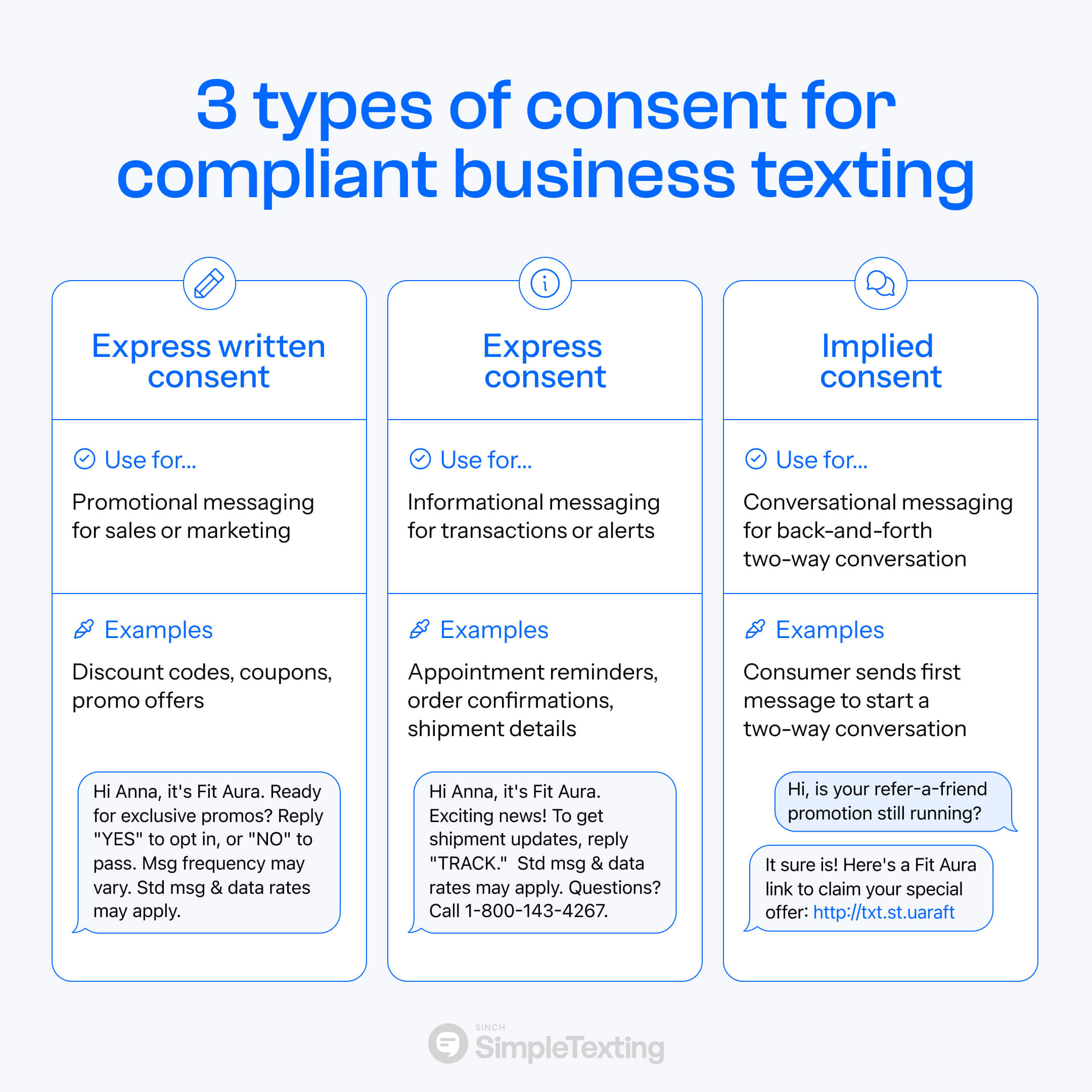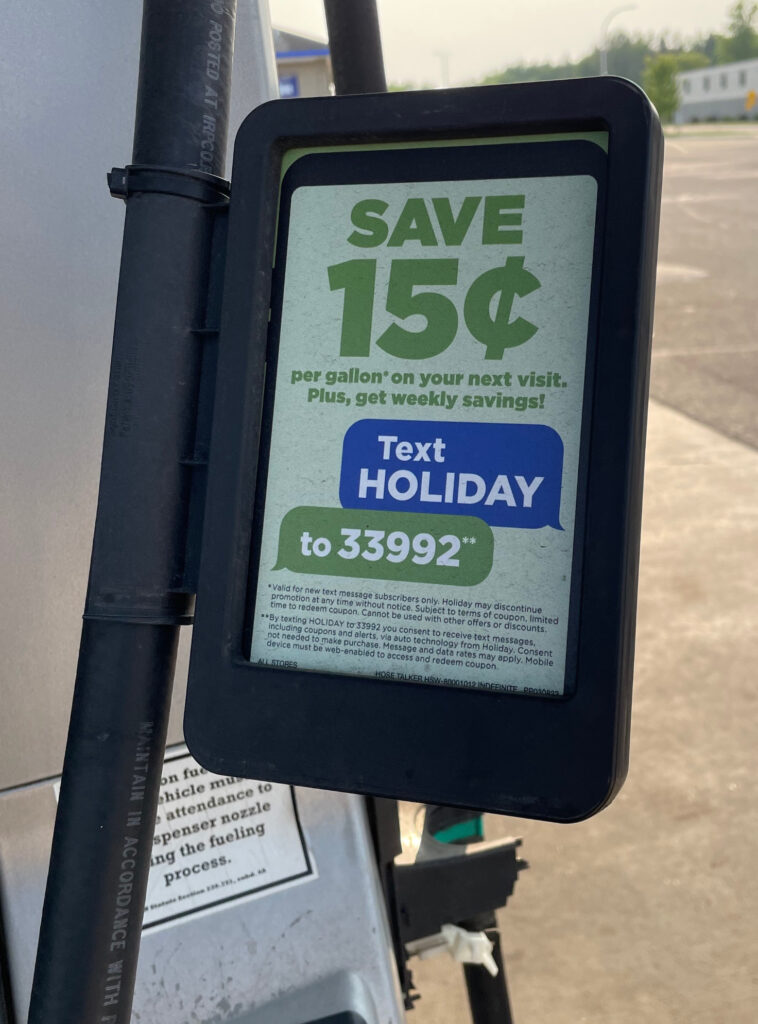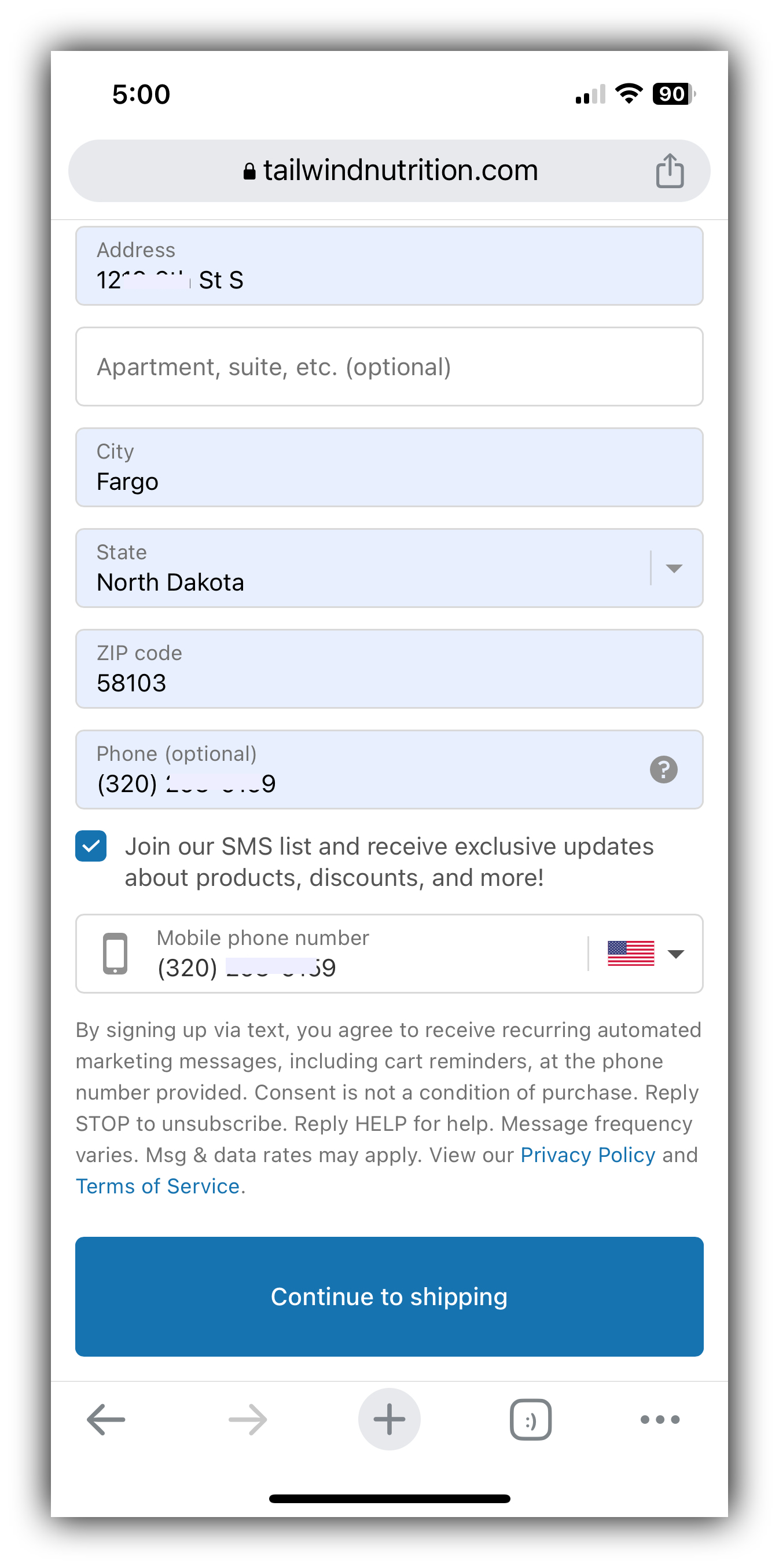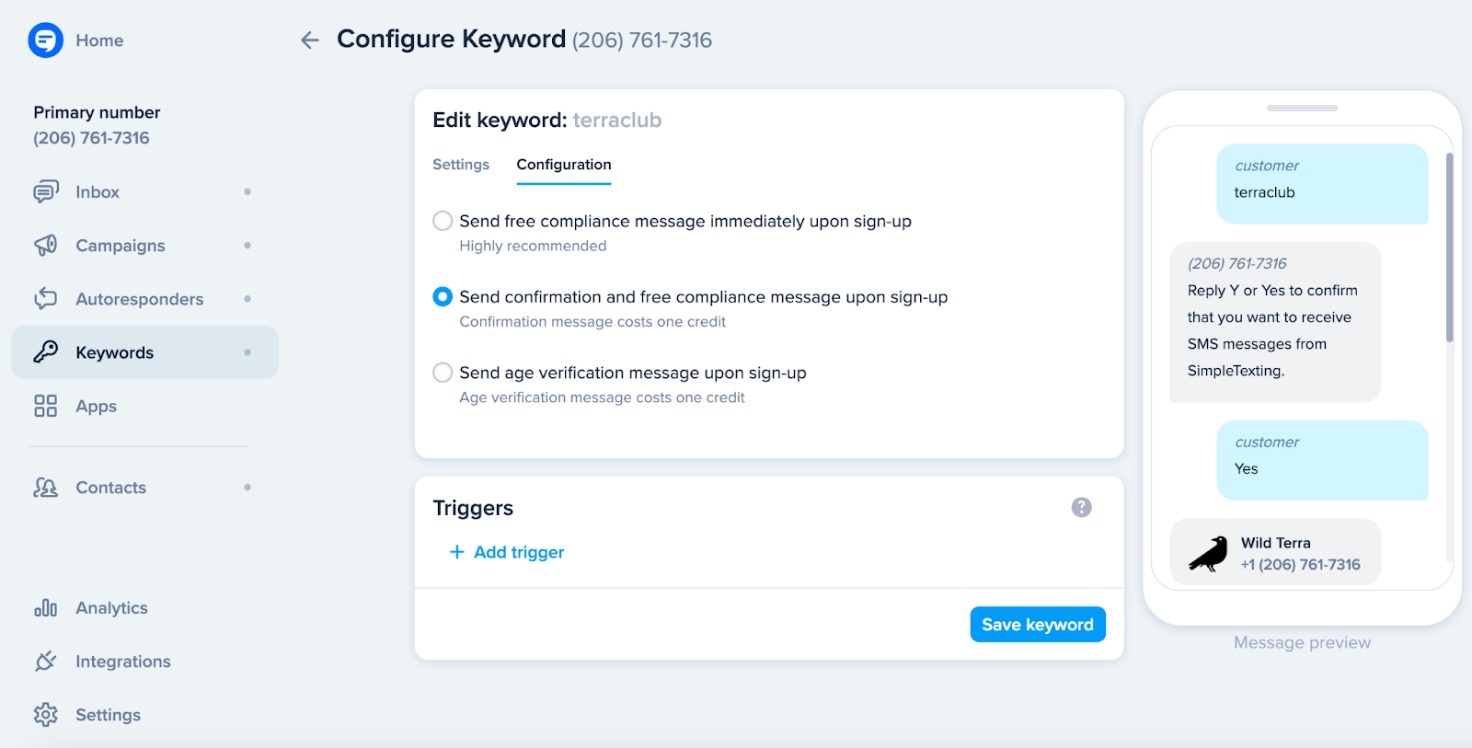Express written consent in text messaging: Everything you need to know
You need consent before your organization texts. Learn about the three types of consent and how to get express written consent.
To send any kind of promotional text message to customers, you need to get their express written consent. Here’s what that is, why it’s so important, and how to get express written consent from your contacts.
⚠️ This advice is for informational purposes only and is neither intended as nor should be substituted for consultation with appropriate legal counsel and/or your organization’s regulatory compliance team.

What is express written consent?
Express written consent is permission given by a consumer — either by hand or digitally — to receive marketing text messages from a business.
The CTIA’s Messaging Principles and Best Practices handbook states:
Before a Non-Consumer sends promotional messages, the Consumer should agree in writing to receive promotional texts. Non-Consumers that already ask Consumers to sign forms or submit contact information can add a field to capture the Consumer’s consent.
Unlike express content, express written consent relies on the recipient:
- Signing a form,
- Checking a box,
- or actively confirming they want to receive messages, like texting you a keyword to join your subscriber list.
Think of it this way: Express written consent is getting a contact to say (or write), “Yes, I’d like to receive marketing messages from you via SMS.”
The main takeaway here is that express written consent is not implied or assumed.
Just because someone has given your business their cell phone number doesn’t mean they have agreed to receive promotional texts from you. Until they have given you written proof signifying their agreement to receive texts in an opt-in with the required terms, you’re risking a violation.
If you’re importing contacts into an SMS marketing platform like SimpleTexting, always double-check you have consent before uploading.
Hang onto those consents, because it is the sender’s duty in a TCPA case to prove that they sent a text with the consumer’s prior express consent. Avoid getting yourself into hot water by getting express written consent for any type of business texting. You’re then not as limited to what you can and can’t send.
Note: SimpleTexting helps you collect express written consent when you use our opt-in tools like text-to-join keywords (via a consumer texting you an opt-in keyword) and web forms (via unchecked box the consumer manually checks to opt in).
Express written consent via keyword example
The types of text messages you can send when you have express written consent include:
- Conversational messages and answers to customer queries
- Informational messages, like appointment reminders and order confirmations
- Discounts and upcoming sales
- Product recommendations
- Launches for your new products or services
- Birthday or special occasion offers
- Flash sales and one-off deals
- Competitions and giveaways
- Loyalty or referral program promotions
When you get express written consent, you can send conversational, informational, and promotional text messages to consumers.
What is express consent?
Express consent is getting written or verbal consent from a consumer to send informational messages that are related to the service or product they’re purchasing.
For example, a customer who books an appointment via your website and provides their phone number is giving express consent for you to send a booking confirmation, reminder messages, and any follow-up information for that appointment.
Consent given in this way (i.e. directly related to a specific action) is different from express written consent because it doesn’t allow you to send promotional messages if they’re not directly related to the product or service the customer originally consented to receive information about.
Express consent via business relationship example
When you get express consent, you can send conversational and informational text messages to consumers.
What is implied consent?
Implied consent isn’t granted by the customer, but is instead granted by their actions.
For example, if a customer sends you a message first, you’re allowed to respond to that individual message without gaining verbal or written permission.
Usually, implied consent applies in situations where the customer makes the first move — like customer support cases or if a customer reaches out to your online live chat to answer a query.
In this instance, you can’t start sending promotional messages because the customer hasn’t explicitly consented to receiving them. If you want to follow up with product or service recommendations or share your upcoming deals, you’ll need to get express written consent before you move forward.
Implied consent via support example
Implied consent only lets you send conversational text messages to consumers.
Why is it important to get express written consent before you send promotional texts?
Texting people without their consent is against the law. You could find yourself facing fines or legal action if you send promotional messages without gaining express written consent.
Aside from being a legal requirement, getting express written consent builds trust with your customers. Most consumers don’t want companies texting them out of the blue, especially if they haven’t signed up for it. Breaking a customer’s trust in this way can lead to loss of business and negatively impact your company’s reputation — not good.
Note: Per SimpleTexting’s terms of service the individual/account/user responsible for sending messages via a SimpleTexting account is ultimately responsible for ensuring that express consent has been obtained (and, ideally, documented for verification purposes in the event of a compliance audit or formal complaint). We have a zero tolerance policy for illegality here at SimpleTexting, and consent violations at the very least can result in account termination.
In the end, express consent is an advantage for your business. It weeds out your passive audience, leaving you with only your most active and interested supporters. This means your messages are more likely to go to people likely to take action. The result — impressive and significant ROI.
How to get express written consent
There are several ways you can get express written consent from your customers.
The CTIA offers several examples to get consumer consent before you text:
Entering a telephone number through a website;
Clicking a button on a mobile webpage;
Sending a message from the Consumer’s mobile device that contains an advertising keyword;
Initiating the text message exchange in which the Message Sender replies to the Consumer only with responsive information;
Signing up at a point-of-sale (POS) or other Message Sender on-site location; or
Opting-in over the phone using interactive voice response (IVR) technology.
That said, there are three primary ways we see businesses get express written consent to send promotional text messages:
Text-to-subscribe keyword
To get express written consent via a text-to-subscribe keyword, you have to actively encourage customers to send a text to you with your chosen keyword. It could be “SUBSCRIBE” or “YES”, but the word itself doesn’t really matter. What matters is that consumers play an active role in the process.
The tricky part is getting customers to take that first step. For example, you might have a pop-up on your website that asks them to send the word “DAILYDEAL” to your SMS number to start receiving your daily deal messages.
You’ll need to provide additional context to the popup that explains what the consumer is signing up for:
Brand Name: By texting KEYWORD to 123-456-7890, you agree to receive promotional messages sent via an autodialer. You also agree to the term of service (website.com/terms) and privacy policy (website.com/privacy). This agreement isn’t a condition of any purchase. Message frequency varies. Message and data rates may apply. Reply STOP to opt out; HELP for more information.

Web form with an unchecked box
Another way to get express written consent is to have consumers tick an unchecked box on a web form. This can be an additional field in an email signup form or an add-on to a booking form. The most important thing is that the box is unchecked in its original state. The explicit written consent comes from the consumer actively checking the box before submitting the web form.
Again, you’ll need to lay out what customers can expect when they check the box (“by checking this box, you agree to receive promotional marketing messages from This Company”).

Physical form with an unchecked box
Similarly to a web form, you can have consumers tick an unchecked box on a physical form as well. Explicit written consent comes when the customer actively checks the box and agrees to receive promotional text messages from you.
When a customer checks the box on a physical form, you must enter it into your system as soon as possible and send a consent confirmation text. Don’t sit on a signed piece of paper for months before you upload it.
The CTIA’s Short Code Monitoring handbook states:
For point of sale (POS) and hardcopy opt-ins, the opt-in confirmation message must be delivered as soon as reasonably possible after the Consumer opts into the program.
Best practice: Double opt-in
To be certain you’ve received explicit written consent from customers, you can implement a double opt-in text message system. When someone checks a box or sends your signup keyword, they’ll be asked once more to confirm they want to receive promotional marketing messages from your business.
While it’s considered good form to double-check that customers do actually want to sign up, double opt-in isn’t mandatory. However, it does give you two forms of written consent: One from a text-to-join keyword or a form and another in a “yes” response from the double opt-in.
It’s good practice to give your customers ample opportunity to understand what they’re signing up for and confirm they agree to it. You can add a double opt-in to your text message sign-ups with SimpleTexting’s Configuration feature.

Confirmation message
After a contact subscribes to receive texts from your organization, send a consent confirmation text message as soon as reasonably possible that includes:
- Business, program, or product name
- Frequency or amount to expect
- Message and data rates may apply
- Help or customer care contact instructions
- Opt-out instructions
Express written consent FAQs
What is an example of express written consent?
What is the difference between express written consent and implied consent?
How can you get express written consent?
- Text-to-subscribe keywords. Ask customers to send a one-word message as their agreement to receive promotional messages.
- Web forms with an unchecked box. Encourage customers to check a box on an online form or popup.
- Physical forms with an unchecked box. Encourage customers to check a box on a paper form.
Key takeaways
- Express written consent is a must if you want to send any kind of promotional marketing
- It’s a good idea to get express written consent in all situations so you’re not limited to the type of text messages you can send
- You can get express written communication through a text-to-subscribe keyword, a web form with an unchecked box, or a physical form with an unchecked box
- Double down on your express written consent by implementing a double opt-in system
- Don’t forget to send a confirmation message as soon as someone provides consent that includes your company name, any data rates, and opt-out instructions
⚠️ This advice is for informational purposes only and is neither intended as nor should be substituted for consultation with appropriate legal counsel and/or your organization’s regulatory compliance team.
Nathan Ellering contributed to this piece.